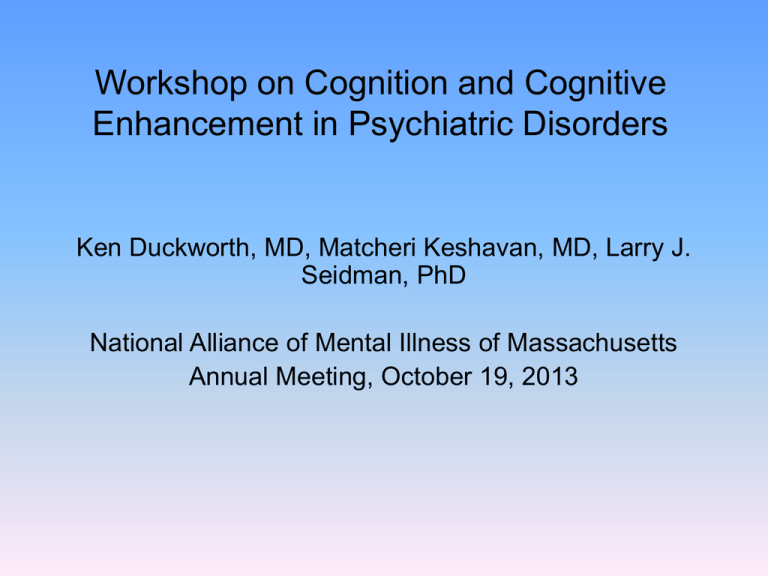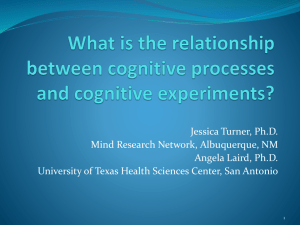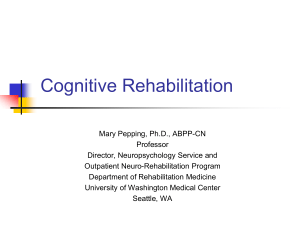Cognitive Enhancement Therapy (CET) presentation slides
advertisement

Workshop on Cognition and Cognitive Enhancement in Psychiatric Disorders Ken Duckworth, MD, Matcheri Keshavan, MD, Larry J. Seidman, PhD National Alliance of Mental Illness of Massachusetts Annual Meeting, October 19, 2013 Bob Public Presentation: • Bright 14 yr old male • History of severe early neglect • Socially anxious • Grades dropped from A’s to B’s, then C’s, eventually D’s • By junior yr of HS, he was failing classes • Few friends, not initiating peer contact Academic Difficulties • • • • • • • • Concentration Initiative Organization Reading Writing Memory Academic supports put in place Discontinued brief psychotherapy What are reasons for neuropsychological assessment? • • • • • • • • Problems in organization and planning Forgetfulness Difficulty concentrating and sustaining studying First-time evaluation - many adults have never received a proper diagnosis. Re-evaluation to determine change over time. Assessment of treatment effects. Request for accommodations in college, exams, etc.. Understanding of own strengths and weaknesses for self and significant others (e.g., parents, spouse). Central Neuropsychological Deficits in Schizophrenia • Executive Functions, Abstraction, Thought Disorder • Sustained and Selective Attention • Working Memory • Verbal Declarative Memory (VDM) Encoding, Storage and Retrieval • Language Age and Neuropsychological Function in Schizophrenia (Fucetola, Seidman et al., 1999) People with Schizophrenia Healthy Controls 0.5 0.5 Young Middle Old Z-Scores 0 0 -0.5 -0.5 -1 -1 -1.5 Young Middle Old -1.5 -2 Verbal Abstraction Visual Executive Mental Motor Control Verbal Perceptual Sustained Memory Motor Attention -2 Verbal Abstraction Visual Executive Mental Motor Verbal Perceptual Control Sustained Memory Motor Attention Neurocognitive Deficits are related to Functional Outcome Community Functioning Neurocognitive Deficits Large - Medium - Small - Instrumental & Problem Solving Skills Psychosocial Rehabilitation Programs 0.8 0.7 0.6 0.5 0.4 0.3 0.2 0.1 0.0 All P’s <.0001 Verbal Memory Immediate Memory Executive Functions Vigilance Summary Scores Green et al, 2000 Schizophrenia: some numbers 1 • 10 • Percent of population prevalence Percent of patients gainfully employed • 20 • Years of reduced longevity • 40 • Percent of patients who do not respond to antipsychotics • 80 • Partial or total noncompliance with treatment • 90 • Percent of patients with cognitive impairment • 100 • Percent of patients with loss of insight at some point or other Nash suffered from paranoid schizophrenia Key points • Brain is remarkably plastic • Altered neuroplasticity and schizophrenia • Plasticity based interventions may remedy cognitive deficits Ramon Cajal 1901 • The nerve pathways are something fixed, ended and immutable… • ….It is for the science of the future to change, if possible, this harsh decree. William James 1890 • ..Nervous tissue, seems endowed with a very extraordinary degree of plasticity … the phenomena of habit in living beings are due to the plasticity Critical periods where environmental enrichments might have larger effects Environment CRITICAL PERIOD Genotype conception Phenotype birth postnatal adolescence adulthood Hubel and Weisel experiments with kitten Neuroplasticity and Critical windows Higher cognitive function Language Psychiatric disorders Dyslexia Primary Sensory (Visual, Auditory) Amblyopia 0 Birth 1 Years 2 4 6 8 10 12 18 24 30 40------(Nelson CA in Neurons to Neighborhoods 2000) •“The more the neurons fire together, the more they wire together” Donald Hebb 1949 Or “Use it or lose it” Long term potentiation Long term plasticity Environmental enrichment leads to neuronal proliferation Van Praag 2000 The neuronal handshake The power of plasticity Physical Practice MEG activity Motor cortex Mental Practice Day 1 2 3 4 5 Pascual-Leone et al. JNP 94 London Taxi drivers have larger hippocampi than matched control subjects McGuire 2009 • Brain is remarkably plastic • Altered neuroplasticity may underlie cognitive deficits in schizophrenia • Plasticity based interventions may remedy cognitive deficits Schizophrenia is.. • A disorder of stages • A cognitive disorder caused by deficits in brain plasticity • A disorder of affect caused by uncontrolled overactivity of emotional brain regions Psychosisof is actually a “late” stage of schizophrenia! Phases the schizophrenic illness. Prodromal Transitional Premorbid Recovery Psychotic Premorbid alterations Decline begins in prodrome Post-illness onset Functional decline Psychosis Typically begins in adolescence Excessive (Positive) symptoms (40-50 %) Hallucinations Delusions Loose associations Cognitive deficits (80-90%) Working memory Selective attention Functional Impairment Deficit (negative) symptoms (60-70 %) Avolition Anhedonia Anergia Asociality Alogia Name the color of the word… Blue Did you have a Yellow STR OOPs! Effect? Red Green Blue Green Healthy persons activate Anterior cingulate when they Detect errors Selective ATTENTION N- Back Test Press when you see the number (n) 2 digits ago 6 Hold 7 Hold 3 Hold 7 Press 5 Hold Normally activates WORKING MEMORY 3 Hold 5 Press Wisconsin card sort Number Color Shape Normally activates Reasoning and conceptual flexibility TACT, or Social cognition: Decreased ventral prefrontal activity with the Baron-Cohen “eyes task” AFFECT PERCEPTION Brain regions engaged in Emotion recognition minus Gender recognition Amygdala Inferior frontal cortex and insula Social perception is that part of perception that allows people to understand the other people in their social world. Faux Pas vignette Baron-Cohen 1999 Helen's husband was throwing a surprise party for her birthday. He invited Sarah, a friend of Helen's, and said, "Don't tell anyone, especially Helen." The day before the party, Helen was over at Sarah's and Sarah spilled some coffee on a new dress that was hanging over her chair. "Oh!" said Sarah, "I was going to wear this to your party!" "What party?" said Helen. "Come on," said Sarah, "Let's go see if we can get the Did stain anyone out." say something they shouldn't have said or something awkward? PERSPECTIVE TAKING: Hinting task Jane is with her father in a mall, and walks by a pet store where she sees a cute puppy. Looking at it, she tells her father “ dad, do you remember it is my birthday next week?” Question: What does Jane want her dad to do? “Getting the gist” Nornally induces Synchronous oscillations (such as gamma waves) PERCEIVING FRAGMENTS as parts of a whole can be difficult for people with schizophrenia. • • • • • • Speed Memory Attention Reasoning Tact/Social cognition Synthesis Effect Size (Cohen's d ) Cognitive deficits in Schizophrenia 0.2 0 -0.2 -0.4 -0.6 -0.8 -1 -1.2 -1.4 -1.6 -1.8 -2 Memory Cognitive deficits in schizophrenia are Pervasive Persistent Present early Progress early Predict functional disability ProblemSolving IQ Attention Perspective- Social Cue taking Recognition Effects Sizes (Cohen’s r): Neurocognitive Deficits and Functional Outcome Community Functioning Neurocognitive Deficits Instrumental & Problem Solving Skills Skill Acquisition 0 .7 0 .6 Large - 0 .5 0 .4 Medium - 0 .3 0 .2 Small - 0 .1 0 .0 Verbal Memory Green et al. 2000 Immediate Memory Executive Functions Vigilance Summary Scores 2. Schizophrenia is a disorder of brain development. At Birth 6 Years Old 14 Years Old Synapse density Normal adolescence is characterized by brain maturational Refinements including synaptic pruning. 0 5 Feinberg 1982, Keshavan 1994; Hoffmann and McGlashan 2000 10 15 20 Schizophrenia is related to excessive pruning of gray matter in higher brain regions Schizophrenia also may be related to failure of white matter expansion Gogtay et al 2008 Brain structure: Frontal and temporal gray matter loss in early schizophrenia VBM (n=400) Meda et al 2008 Brain function: Reduced prefrontal Function Meta-analysis, Glahn et al 2005 Brain physiology:: Reduced Gamma oscillations Spencer, McCarley 2004 Reduced brain plasticity in schizophrenia may impair learning Impaired learning in schizophrenia Reduced cortical stimulation with TMS Daskalaikis 2010; Pascual-Leone 2011 Decreased cortical plasticity correlates with Impaired learning Cortex Dopamine/ Glutamatergic deficit Impaired affect expression Increased arousal, Dysregulation, Psychosis Impaired cortico-limbic connectivity Cognitive deficits, Negative symptoms Limbic Regions (i.e. amygdala) Increased Mesolimbic Dopamine Mid-brain 3. Such deficits higher brain regions lead to “disinhibition” of emotional brain regions Leading to psychosis and mood instability Aleman and Kahn 2005; Weinberger 1987 • What is brain plasticity? • Altered neuroplasticity may underlie cognitive deficits in schizophrenia • Plasticity based interventions may remedy cognitive deficits and improve outcome – – – – – The PRISM Principles of cogntive remediation CET and how it is applied Does CET work? How does it work? What are the next steps? COGNITION AND NEUROTRANSMITTERS Norepinephrine Acetylcholine Stimulants Dopamine Atomoxetine (nicotinergic) COMT antagonists Modafinil Nicotinic agonists Acetylcholine (muscarinic) Histamine H3 antagonists Ach-ase antagonists Muscarinic agonists Cannabinoid receptors GABA GABA agonists Glutamate CB1 antagonists Glutamate agonists NMDA antagonists Several pharmacologic agents being tried now for cognitive deficits in schizophrenia, but have little benefit Pharmacological Treatments for Cognition Effect Size (Cohen's d ) Enter: cognitive remediation 1 0.9 (L) 0.8 0.7 0.6 (M) 0.5 0.4 0.3 (S) 0.2 0.1 0 Antipsychotics d-Cycloserine (Keefe (Buchanan et et al., 2007) al., 2007) Glycine (Buchanan et al., 2007) Galantamine Practice Effect (Buchanan et (Goldberg et al., 2008) al., 2007) Worse Better Cognitive remediation works! Til Wykes et al 2011 The meta-analysis (2,104 participants) yielded durable effects on global cognition and functioning. PRINCIPLES OF COGNITIVE REMEDIATION #1: PROGRESSIVE.. AND BOTTOM-UP. Psychophysical Improvement on the Auditory discrimination Training Exercise predicts Improvement in Global Cognition Composite Score Adcock, R. A. et al. Schizophr Bull 2009 35:1132-1141; doi:10.1093/schbul/sbp068 “Bottom-up”Improvements in elemental cognitions predict global cognitive benefits Copyright restrictions may apply. PRINCIPLES OF COGNITIVE REMEDIATION #2: REPETITION AND PRACTICE. •“The more the neurons fire together, the more they wire together” Long term plasticity PRINCIPLES OF COGNITIVE REMEDIATION #3.. Individualizing the cognitive training. • intrinsically motivating instructional approach – (a) Tailoring the interventions to the individual’s cognitive style. – (b) Personalizing elements of the learning materials into themes of high interest value, – (c) Autonomy. so patients can increase their control over the learning process. Choi and Medalia 2009 PRINCIPLES OF COGNITIVE REMEDIATION #4 Stress management High level of stress/ arousal diminishes performance. 4. Strategy and Top-down approaches work better 1 0.9 0.8 0.7 0.6 0.5 0.4 0.3 0.2 0.1 0 McGurk et al CR+ CR+ Rehab Rehab CRCR- Rehab Rehab PRINCIPLES OF COGNITIVE REMEDIATION #5: MOTIVATION. Gard et al 2009 (a) personalizing elements of the learning materials into themes of high interest value, (b) Autonomy. so patients can increase their control over the learning process. (c) Using exercises that are engaging. Intrinsic motivation Principles of CET • Progressive, “Bottom-up” • Repetition, and Practice. • Individualized to patient’s cognitive style, ability and progress • Stress Free, Success oriented and Strategic, Top-Down • Motivation, Focus on Intrinsic motivation Components of CET • Support, education, Internal coping • Neurocognitive remediation – Attention, memory, and problemsolving modules (1 – 1.5 hours/week; ~60 hours) – Done in pairs; computer exercises; Computer exercises done in pairs coaching by clinician • Social-Cognitive Group Therapy – Training in perspective-taking, gistfulness, – non-verbal communication, emotional temperature perception, etc (1.5 hours/week; about 45 sessions) Group sessions with homework – Acting wisely in social situations; –www.CognitiveEnhancementTherapy.com Appraising the social context; CET is effective in chronic as well as early course schizophrenia Hogarty.. et al 2004; Eack…Keshavan 2009 CET has Real-world benefits on Functioning and Symptoms (3 year follow up) • Functioning (pervasive) – Employment (CET=58%; EST=19%) – Social functioning – Global adjustment – Activities of daily living • Symptoms – Negative symptoms – Anxiety and depression – No effects on positive symptoms, as expected Eack, Greenwald, Keshavan Psychological Medicine 2010 What predicts response to CET? More gray and white matter (“brain reserve”) to begin with, the better is the response to CET Keshavan et al 2011 The more the brain change, the larger was the improvement in social cognition Eack et al Arch Gen Psychiatry 2010 CET benefits are durable in early course schizophrenia even after discontinuing treatment ESSENCE study Eack..Keshavan Schiz Res 2010 Cognitive impairments and remediation effects are agnostic to diagnoses Cognitive flexibility Attention bias ( Emotion regulation WM interference Social cognition deficits ADHD (Wexler, Tamm, Halperin) * * * ** - Anxiety d/o (Etkin, Bar-Heim)) * ** ** * - MDD (Etkin) Bipolar disorder (Dickstein) ** ** ** ** ** ** ** ** * Autism (Eack, Scherf) ** ** ** * *** Schizophrenia (Eack, Vinogradov, Keshavan), VLFS (Kates) *** *** *** *** *** Healthy aging (Gazzaly) NIH workshop April 2012; Keshavan et al Am J Psychiatry Under Review * Cognitive remediation releases Brain derived neurotrophic factor BDNF also powerfully Induced by: Physical exercise SSRIs Ampakines TMS Serum brain-derived neurotrophic factor (BDNF) levels (ng/mL) in schizophrenia subjects participating in 50 hours of computerized auditory training (AT) versus subjects participating in 50 hours of computer games (CG). Vinogradov et al 2009 Can brain stimulation enhance benefits with cognitive remediation? • Repetitive transcranial magnetic stimulation for negative symptoms of schizophrenia: review and metaanalysis. Dlabac-de Lange JJ, Knegtering R, Aleman A. J Clin Psychiatry. 2010 Apr;71(4):411-8. Epub 2010 Feb 23. Studies with a longer duration of treatment (> or =3 weeks) had a larger mean effect size when compared to studies with a shorter treatment duration: d = 0.58 (95% CI, 0.19-0.97) and d = 0.32 (95% CI, -0.3 to 0.95), respectively. New directions 0.7 0.6 0.5 • CR+ other psychosocial (e.g. Supportive employment, Metacognitive therapy, Motivation enhancement, CBT) • CR+Pharmacologic; addition as well as subtraction? • CR+Brain stimulation/other non-pharmacological approaches (TBS, TDC, rTMS • CR+ Motor/physical exercise 0.4 Adjunctive PR No Adjunctive PR 0.3 0.2 0.1 0 McGurk et al., 2007 N=11 Wykes et al., 2011 N=19 Key question: Value of strategic combinations Combining treatments: more than the sum of its parts Medication “subtractions” can help cognition • Unnecessary use of anticholinergic (antiparkinson), sedatives and antihistamine medications (such as diphenhydramine) to be avoided • Some mood stabilizers may interfere with cognition (e.g. Topiramate) • Too many medications in general and use of too high a dose to be avoided Other approaches:Cognitive adaptation is of value as well (Velligan et al 2006) Global Cognition Improved After training in schizophrenia prodrome MATRICS T-Scores 60 p=.008* [d=.43] T-Score 55 p=.056 50 [d=.25] p=.055 Pre TCT [d=.26] Post TCT 45 40 Hooker et al unpublished Cognitive Domain Prodromal Positive Symptoms Improved After Training SIPS: Structured Interview for Prodromal Syndromes 16 p=.05* [.28] severity level 14 12 10 8 6 Pre TCT 4 Post TCT 2 0 Positive Hooker et al unpublished Negative Disorganization Symptoms General Take home points • The brain has a remarkable ability to repair itself, a phenomenon known as plasticity • Cognitive deficits (Speed, Memory, Attention, Reasoning, Tact, Synthesis) are related to altered brain plasticity • Cognitive deficits and the brain changes may be reversible with neuroplasticity based cognitive remediation, have durable real-world benefits • Cognitive remediation works best when it is Progressive, Repetitive, Individualized,Strategic and includes a Motivational component. • Deficits in brain plasticity may set in early. Early intervention may have large positive implications for outcome Thanks to • • • • • • • • • • • • • Mary Carter PhD Susan Cooley Raymond Cho MD Anne-Louis DiBarry Shaun Eack PhD Sam Flesher PhD Debbie Greenwald PhD Susan Hogarty MSN Summer Mcknight Diana Mermon MA Jean Miewald MA Debra Montrose PhD Konasale Prasad MD • • • • • • • • • • • • Alyssa Alfieri MA Angelica Daiello BS Ann Findiessen Irakles Giakoumatos Chiara Haller PhD Rosa Johnson Raquelle MesholamGateley PhD Tom Monteleone Corin Pilo MSW Larry Seidman PhD Heidi Thermenos PhD Joanne Wojcik PhD AND OF COURSE ALL OUR STUDY PARTICIPANTS






